|
Historical
Information

Although the first sawmill had been established on the banks of the
Manistee in 1841, settlement in the area was not widespread until the
Chippewa relinquished their reservation by treaty in 1849, and the
federal government offered lands along the Manistee for public sale. It
did not take lumber interests long to realize the incredible potential
of the Manistee which snaked a hundred miles into the forests, and
lumbermen soon began lobbying for federal funding to improve the harbor
and to erect a lighthouse at the river mouth. With no appropriation
forthcoming, the businessmen of Manistee took the matter into their own
hands, erecting a pair of short stub piers at the river mouth in an
attempt to stem the deposition of sand and silt.
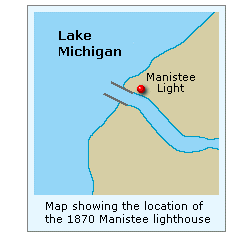 Congress instructed the Army Corps of Engineers to dispatch
an Engineer Officer to Manistee to conduct a survey of the river
entrance in 1861. While the Engineering report indicated that harbor
improvements at Manistee were both necessary and valid, nothing would be
done until 1867 when appropriations were simultaneously approved for
improvements to the river entrance and for the erection of a lighthouse
to guide vessels into the new entry on its completion. Improvements
began in July 1867 under the direction of Mr. John Canfield, and that
same year, a survey party was sent to Manistee to select and survey a
site on the north shore of the river mouth for the new lighthouse
reservation. Congress instructed the Army Corps of Engineers to dispatch
an Engineer Officer to Manistee to conduct a survey of the river
entrance in 1861. While the Engineering report indicated that harbor
improvements at Manistee were both necessary and valid, nothing would be
done until 1867 when appropriations were simultaneously approved for
improvements to the river entrance and for the erection of a lighthouse
to guide vessels into the new entry on its completion. Improvements
began in July 1867 under the direction of Mr. John Canfield, and that
same year, a survey party was sent to Manistee to select and survey a
site on the north shore of the river mouth for the new lighthouse
reservation.
Work on the new station began in 1869 with the excavation of a
cellar and the erection of a rubble stone foundation. Atop this
foundation, a wood-framed dwelling with an integrated tower was erected,
and outfitted with a Fifth Order lens. With expected completion close at
hand, Octavius W Barney was appointed as the station’s first Keeper,
reporting for duty at Manistee on December 30, 1869, when work was
suspended with the arrival of winter. Although considerable work
remained to be completed at the station, work on the tower had
progressed to the point that Barney was able to exhibit the new Manistee
light on the opening of the 1870 navigation season. As construction
continued through the spring, it was discovered that the building had
been mistakenly erected too close to the rear of the reservation, and
that a small addition at the rear of the dwelling was located beyond the
surveyed reservation. Work was temporarily suspended until arrangements
were made to purchase additional land at the rear of the reservation for
the princely sum of $30.00. Work on the new station finally came to a
close in July 1870. The construction crew departed, leaving Barney to
tend the light alone.
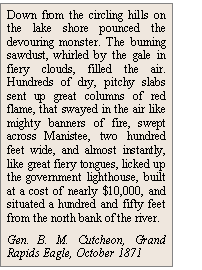 Barney resigned his position as Keeper of the Manistee Light on April
24, 1871, and was replaced by John McKee. Manistee of 1871 was a flurry
of activity with river entry and harbor improvements well underway, and
the mouth of the river now accessible to the largest vessels. The river
was being opened-up deep into the heartland, and with the new lighthouse
serving as an excellent guide to the increasing volume of vessels
entering the bustling harbor, the residents of Manistee sensed their
town was poised for greatness. Barney resigned his position as Keeper of the Manistee Light on April
24, 1871, and was replaced by John McKee. Manistee of 1871 was a flurry
of activity with river entry and harbor improvements well underway, and
the mouth of the river now accessible to the largest vessels. The river
was being opened-up deep into the heartland, and with the new lighthouse
serving as an excellent guide to the increasing volume of vessels
entering the bustling harbor, the residents of Manistee sensed their
town was poised for greatness.
Then on October 8, 1871, all Hell broke loose. A huge fire, which had
been sweeping through the area forests finally reached Manistee. Fed by
the mountainous piles of lumber and shingles lining the river banks, the
fire jumped the wooden bridge across the river, completely consuming the
town on its inexorable push south. When the fire had passed, the entire
town lay in smoldering ruins, including the lighthouse which had burned
to the ground foundation. As the townsfolk tried to rescue the few
remaining possessions of their former lives, Keeper McKee toiled for two
days to establish a temporary light atop a pole near the lakeshore to
serve until more permanent arrangements could be made. With the
lighthouse a complete loss, Congress appropriated $10,000 for
construction of a new light on May 18, 1872.
 Eleventh District Engineer Major Orlando Poe responded quickly,
dispatching a work party and materials to Manistee that July, with the
crew working at a feverish pace to complete the reconstruction. On
completion, the new dwelling appears to have been a virtual duplicate of
the original station, consisting of a 2-story wood structure with
clapboard siding with an integral wooden tower at its lakeward gable
end, and capped by an octagonal cast iron lantern. Since the original
Fifth Order Fresnel lens had been destroyed in the fire, a new lens was
ordered from Paris, and a temporary lens was displayed in the lantern on
completion of the new station that September. The new lens was finally
received at the Detroit depot late in 1873, and after shipment to
Manistee, replaced the temporary lens in the lantern. Eleventh District Engineer Major Orlando Poe responded quickly,
dispatching a work party and materials to Manistee that July, with the
crew working at a feverish pace to complete the reconstruction. On
completion, the new dwelling appears to have been a virtual duplicate of
the original station, consisting of a 2-story wood structure with
clapboard siding with an integral wooden tower at its lakeward gable
end, and capped by an octagonal cast iron lantern. Since the original
Fifth Order Fresnel lens had been destroyed in the fire, a new lens was
ordered from Paris, and a temporary lens was displayed in the lantern on
completion of the new station that September. The new lens was finally
received at the Detroit depot late in 1873, and after shipment to
Manistee, replaced the temporary lens in the lantern.
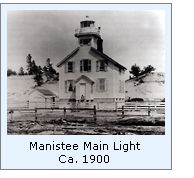 1874 and 1875 were exceptionally busy years for Manistee, with 3,488,
vessels entering the river between June 30, 1874, and June 30, 1875. To
serve this burgeoning maritime commerce, the piers were extended an
additional 150 feet in 1875, and the channel between them dredged to a
minimum depth of ten feet. With the main light now standing a
considerable distance to the rear of the pierheads, the decision was
made to replace the shore light on the north bank with a pierhead beacon
on the outer end of the longer south pier. On establishment of the new
south pierhead beacon on the night of October 15, 1875, the main light
was discontinued, only three years after the station was rebuilt. 1874 and 1875 were exceptionally busy years for Manistee, with 3,488,
vessels entering the river between June 30, 1874, and June 30, 1875. To
serve this burgeoning maritime commerce, the piers were extended an
additional 150 feet in 1875, and the channel between them dredged to a
minimum depth of ten feet. With the main light now standing a
considerable distance to the rear of the pierheads, the decision was
made to replace the shore light on the north bank with a pierhead beacon
on the outer end of the longer south pier. On establishment of the new
south pierhead beacon on the night of October 15, 1875, the main light
was discontinued, only three years after the station was rebuilt.
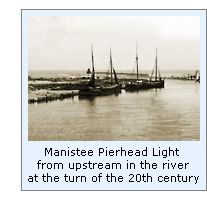 While the structure no longer served as an active aid to navigation,
it continued to serve as a dwelling for Keeper McKee, who was now forced
to row across the river numerous times during each day and night to tend
the pierhead light. However, McKee’s inconvenience was short-lived, as
he was removed from his position on October 26, 1875 and William King
appointed as his replacement. While the structure no longer served as an active aid to navigation,
it continued to serve as a dwelling for Keeper McKee, who was now forced
to row across the river numerous times during each day and night to tend
the pierhead light. However, McKee’s inconvenience was short-lived, as
he was removed from his position on October 26, 1875 and William King
appointed as his replacement.
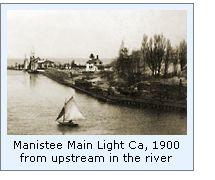 The volume of traffic along the coast heading to and from the Straits
continued to increase, and in 1893 the decision was made to reactivate
the main light to serve double duty as both a coast light and to better
guide mariners to the river mouth. The futility of having the keepers
simultaneously attend the reactivated main light on the north side of
the river and the fog signal and the ranges on the south pier became
clear, and the fog signal and pierhead light were relocated to the north
pier in 1894. A new fixed white Fifth Order Fresnel lens exhibiting a
red flash every 45 seconds was installed in the lantern on the Main
Light, and the station officially reestablished on the night of June 18,
1894. The volume of traffic along the coast heading to and from the Straits
continued to increase, and in 1893 the decision was made to reactivate
the main light to serve double duty as both a coast light and to better
guide mariners to the river mouth. The futility of having the keepers
simultaneously attend the reactivated main light on the north side of
the river and the fog signal and the ranges on the south pier became
clear, and the fog signal and pierhead light were relocated to the north
pier in 1894. A new fixed white Fifth Order Fresnel lens exhibiting a
red flash every 45 seconds was installed in the lantern on the Main
Light, and the station officially reestablished on the night of June 18,
1894.
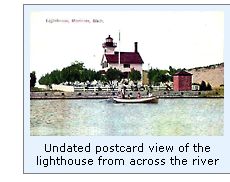 The following year, 100 cubic yards of muck and clay were delivered
and spread atop the sand on the main lighthouse grounds in order to
provide a base for a lawn, and a rail fence was also erected around the
edge of the reservation, completely enclosing the property. The following year, 100 cubic yards of muck and clay were delivered
and spread atop the sand on the main lighthouse grounds in order to
provide a base for a lawn, and a rail fence was also erected around the
edge of the reservation, completely enclosing the property.
After recurring problems with the rotational mechanism on the main
light, the light was temporarily extinguished from February 24 to March
5, 1902, while the District Lampist installed a new pedestal and ball
bearings assembly beneath the lens. While on site, the Lampist also
installed new improved Fifth order lamps in both the main and pierhead
lights. 1906 saw the installation of 600 feet of concrete walkways
connecting the buildings on the main lighthouse reservation.
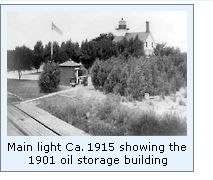 The fog signal building was removed from the north pier in 1927, and
replaced by a 39 foot-tall iron tower on the outer end of the pier, and
with the establishment of these new aids to navigation, the old Main
Light was permanently extinguished and decommissioned. No
longer serving any official government purpose, the lantern was removed
from the structure and the building transferred into private ownership. The fog signal building was removed from the north pier in 1927, and
replaced by a 39 foot-tall iron tower on the outer end of the pier, and
with the establishment of these new aids to navigation, the old Main
Light was permanently extinguished and decommissioned. No
longer serving any official government purpose, the lantern was removed
from the structure and the building transferred into private ownership.
With plans underway for the construction of the sprawling Harbor
Village condominium complex in the area in 1993, the old building found
itself smack-dab in the middle of the developing area, and the structure
was lifted and moved to a residential area in town, where it sits to
this day on West Melitzer Street at the end of Third Avenue, its
original purpose virtually indistinguishable.

Keepers of this Light

Click Here to see
a complete listing of all Manistee Light keepers compiled by Phyllis L.
Tag of Great Lakes Lighthouse Research.

Seeing this Light

The weather was perfect at
Manistee. The sun burned-off the clouds, the breeze dropped to an almost
imperceptible level, and the lake laid-down flat as a billiard
table.
We walked the pier, and looked at the catwalk, which runs the entire
length of the pier.
We wondered at how rough the weather must get in the fall and spring to
require such a structure to be built. On a day such as this, it was difficult to think of this place as
anything other than a peaceful place to walk!

Finding this Light

From US31, take Memorial Drive West approximately one mile to the Lake.
Note that Memorial Drive changes to 5th Avenue along the way.

Contact
information
Manistee County Historical Museum
425 River Street
Manistee, MI 49660
(616) 723-5531

Reference Sources
Journals of the US Senate and
House of Representatives, various, 1851 - 1872
Annual report of the Fifth Auditor of the Treasury, 1838
History of Manistee county, Michigan, H.R. Page & Co.,
Chicago, 1882
Annual reports of the Lighthouse Board, various, 1852 - 1909
Annual reports of the Lake Carriers Association, various, 1914 -
1930
Around the Shores of Lake Michigan, Margaret Beattie Bogue, 1985
Personal observation at Manistee, 09/05/1998.
Keeper listings for this light appear courtesy of Great
Lakes Lighthouse Research
|
 Congress instructed the Army Corps of Engineers to dispatch
an Engineer Officer to Manistee to conduct a survey of the river
entrance in 1861. While the Engineering report indicated that harbor
improvements at Manistee were both necessary and valid, nothing would be
done until 1867 when appropriations were simultaneously approved for
improvements to the river entrance and for the erection of a lighthouse
to guide vessels into the new entry on its completion. Improvements
began in July 1867 under the direction of Mr. John Canfield, and that
same year, a survey party was sent to Manistee to select and survey a
site on the north shore of the river mouth for the new lighthouse
reservation.
Congress instructed the Army Corps of Engineers to dispatch
an Engineer Officer to Manistee to conduct a survey of the river
entrance in 1861. While the Engineering report indicated that harbor
improvements at Manistee were both necessary and valid, nothing would be
done until 1867 when appropriations were simultaneously approved for
improvements to the river entrance and for the erection of a lighthouse
to guide vessels into the new entry on its completion. Improvements
began in July 1867 under the direction of Mr. John Canfield, and that
same year, a survey party was sent to Manistee to select and survey a
site on the north shore of the river mouth for the new lighthouse
reservation. Barney resigned his position as Keeper of the Manistee Light on April
24, 1871, and was replaced by John McKee. Manistee of 1871 was a flurry
of activity with river entry and harbor improvements well underway, and
the mouth of the river now accessible to the largest vessels. The river
was being opened-up deep into the heartland, and with the new lighthouse
serving as an excellent guide to the increasing volume of vessels
entering the bustling harbor, the residents of Manistee sensed their
town was poised for greatness.
Barney resigned his position as Keeper of the Manistee Light on April
24, 1871, and was replaced by John McKee. Manistee of 1871 was a flurry
of activity with river entry and harbor improvements well underway, and
the mouth of the river now accessible to the largest vessels. The river
was being opened-up deep into the heartland, and with the new lighthouse
serving as an excellent guide to the increasing volume of vessels
entering the bustling harbor, the residents of Manistee sensed their
town was poised for greatness. Eleventh District Engineer Major Orlando Poe responded quickly,
dispatching a work party and materials to Manistee that July, with the
crew working at a feverish pace to complete the reconstruction. On
completion, the new dwelling appears to have been a virtual duplicate of
the original station, consisting of a 2-story wood structure with
clapboard siding with an integral wooden tower at its lakeward gable
end, and capped by an octagonal cast iron lantern. Since the original
Fifth Order Fresnel lens had been destroyed in the fire, a new lens was
ordered from Paris, and a temporary lens was displayed in the lantern on
completion of the new station that September. The new lens was finally
received at the Detroit depot late in 1873, and after shipment to
Manistee, replaced the temporary lens in the lantern.
Eleventh District Engineer Major Orlando Poe responded quickly,
dispatching a work party and materials to Manistee that July, with the
crew working at a feverish pace to complete the reconstruction. On
completion, the new dwelling appears to have been a virtual duplicate of
the original station, consisting of a 2-story wood structure with
clapboard siding with an integral wooden tower at its lakeward gable
end, and capped by an octagonal cast iron lantern. Since the original
Fifth Order Fresnel lens had been destroyed in the fire, a new lens was
ordered from Paris, and a temporary lens was displayed in the lantern on
completion of the new station that September. The new lens was finally
received at the Detroit depot late in 1873, and after shipment to
Manistee, replaced the temporary lens in the lantern. 1874 and 1875 were exceptionally busy years for Manistee, with 3,488,
vessels entering the river between June 30, 1874, and June 30, 1875. To
serve this burgeoning maritime commerce, the piers were extended an
additional 150 feet in 1875, and the channel between them dredged to a
minimum depth of ten feet. With the main light now standing a
considerable distance to the rear of the pierheads, the decision was
made to replace the shore light on the north bank with a pierhead beacon
on the outer end of the longer south pier. On establishment of the new
south pierhead beacon on the night of October 15, 1875, the main light
was discontinued, only three years after the station was rebuilt.
1874 and 1875 were exceptionally busy years for Manistee, with 3,488,
vessels entering the river between June 30, 1874, and June 30, 1875. To
serve this burgeoning maritime commerce, the piers were extended an
additional 150 feet in 1875, and the channel between them dredged to a
minimum depth of ten feet. With the main light now standing a
considerable distance to the rear of the pierheads, the decision was
made to replace the shore light on the north bank with a pierhead beacon
on the outer end of the longer south pier. On establishment of the new
south pierhead beacon on the night of October 15, 1875, the main light
was discontinued, only three years after the station was rebuilt. While the structure no longer served as an active aid to navigation,
it continued to serve as a dwelling for Keeper McKee, who was now forced
to row across the river numerous times during each day and night to tend
the pierhead light. However, McKee’s inconvenience was short-lived, as
he was removed from his position on October 26, 1875 and William King
appointed as his replacement.
While the structure no longer served as an active aid to navigation,
it continued to serve as a dwelling for Keeper McKee, who was now forced
to row across the river numerous times during each day and night to tend
the pierhead light. However, McKee’s inconvenience was short-lived, as
he was removed from his position on October 26, 1875 and William King
appointed as his replacement. The volume of traffic along the coast heading to and from the Straits
continued to increase, and in 1893 the decision was made to reactivate
the main light to serve double duty as both a coast light and to better
guide mariners to the river mouth. The futility of having the keepers
simultaneously attend the reactivated main light on the north side of
the river and the fog signal and the ranges on the south pier became
clear, and the fog signal and pierhead light were relocated to the north
pier in 1894. A new fixed white Fifth Order Fresnel lens exhibiting a
red flash every 45 seconds was installed in the lantern on the Main
Light, and the station officially reestablished on the night of June 18,
1894.
The volume of traffic along the coast heading to and from the Straits
continued to increase, and in 1893 the decision was made to reactivate
the main light to serve double duty as both a coast light and to better
guide mariners to the river mouth. The futility of having the keepers
simultaneously attend the reactivated main light on the north side of
the river and the fog signal and the ranges on the south pier became
clear, and the fog signal and pierhead light were relocated to the north
pier in 1894. A new fixed white Fifth Order Fresnel lens exhibiting a
red flash every 45 seconds was installed in the lantern on the Main
Light, and the station officially reestablished on the night of June 18,
1894. The following year, 100 cubic yards of muck and clay were delivered
and spread atop the sand on the main lighthouse grounds in order to
provide a base for a lawn, and a rail fence was also erected around the
edge of the reservation, completely enclosing the property.
The following year, 100 cubic yards of muck and clay were delivered
and spread atop the sand on the main lighthouse grounds in order to
provide a base for a lawn, and a rail fence was also erected around the
edge of the reservation, completely enclosing the property. The fog signal building was removed from the north pier in 1927, and
replaced by a 39 foot-tall iron tower on the outer end of the pier, and
with the establishment of these new aids to navigation, the old Main
Light was permanently extinguished and decommissioned. No
longer serving any official government purpose, the lantern was removed
from the structure and the building transferred into private ownership.
The fog signal building was removed from the north pier in 1927, and
replaced by a 39 foot-tall iron tower on the outer end of the pier, and
with the establishment of these new aids to navigation, the old Main
Light was permanently extinguished and decommissioned. No
longer serving any official government purpose, the lantern was removed
from the structure and the building transferred into private ownership.